Related Research Articles
1993 RP is a trans-Neptunian object discovered by astronomers David Jewitt and Jane Luu at Mauna Kea Observatory on 15 September 1993. It was one of the first few trans-Neptunian objects discovered after Pluto and Charon, but it was not observed long enough to to determine its orbit and ended up becoming lost for over two decades. 1993 RP was serendipitously reobserved in 2015–2016 by Edward Ashton, John Kavelaars, and Brett Gladman at Mauna Kea Observatory, but was announced as a new trans-Neptunian object under the provisional designation 2015 VR202. 2015 VR202 was not recognized to be the same object as 1993 RP until it was identified by Peter VanWylen on 14 August 2023.
474640 Alicanto, provisionally designated 2004 VN112, is a detached extreme trans-Neptunian object. It was discovered on 6 November 2004, by American astronomer Andrew C. Becker at Cerro Tololo Inter-American Observatory in Chile. It never gets closer than 47 AU from the Sun (near the outer edge of the main Kuiper belt) and averages more than 300 AU from the Sun. Its large eccentricity strongly suggests that it was gravitationally scattered onto its current orbit. Because it is, like all detached objects, outside the current gravitational influence of Neptune, how it came to have this orbit cannot yet be explained. It was named after Alicanto, a nocturnal bird in Chilean mythology.

(612584) 2003 QX113 is a large trans-Neptunian object from the scattered disc located in the outermost region of the Solar System. It is one of the most distant objects from the Sun at 60.5 AU. It was discovered by astronomers with the Canada–France Ecliptic Plane Survey at Mauna Kea Observatories, Hawaii, when it was near aphelion on 31 August 2003. It was provisionally designated 2003 QX113.
2010 KZ39 is a trans-Neptunian object orbiting the Sun as a detached object in the outer reaches of the Solar System. The object was first observed on 21 May 2010 by astronomers Andrzej Udalski, Scott Sheppard, M. Szymanski and Chad Trujillo at the Las Campañas Observatory in Chile.

(523622) 2007 TG422, provisional designation 2007 TG422, is a trans-Neptunian object on a highly eccentric orbit in the scattered disc region at the edge of Solar System. Approximately 260 kilometers (160 miles) in diameter, it was discovered on 3 October 2007 by astronomers Andrew Becker, Andrew Puckett and Jeremy Kubica during the Sloan Digital Sky Survey at Apache Point Observatory in New Mexico, United States. According to American astronomer Michael Brown, the bluish object is "possibly" a dwarf planet. It belongs to a group of objects studied in 2014, which lead to the proposition of the hypothetical Planet Nine.

2012 VP113, also known by its nickname "Biden", is a trans-Neptunian object of the sednoid population, located in the outermost reaches of the Solar System. It was first observed on 5 November 2012 by American astronomers Scott Sheppard and Chad Trujillo at the Cerro Tololo Inter-American Observatory in Chile. The discovery was announced on 26 March 2014. The object probably measures somewhere between 300 and 1000 km in diameter, possibly large enough to be a dwarf planet.
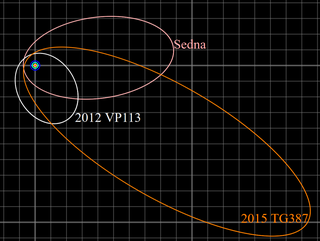
A sednoid is a trans-Neptunian object with a perihelion well beyond the Kuiper cliff at 47.8 AU. Only four objects are known from this population: 90377 Sedna, 2012 VP113, 541132 Leleākūhonua (2015 TG387), and 2021 RR205, but it is suspected that there are many more. All four have perihelia greater than 55 AU. These objects lie outside an apparently nearly empty gap in the Solar System and have no significant interaction with the planets. They are usually grouped with the detached objects. Some astronomers consider the sednoids to be inner Oort cloud objects (OCOs), though the inner Oort cloud, or Hills cloud, was originally predicted to lie beyond 2,000 AU, beyond the aphelia of the four known sednoids.

2014 FC69 is a trans-Neptunian object of the scattered disc on an eccentric orbit in the outermost region of the Solar System. It was first observed on 25 March 2014, by American astronomers Scott Sheppard and Chad Trujillo at the Cerro Tololo Observatory in Chile. It is one of the most distant objects from the Sun, even further away than Sedna.
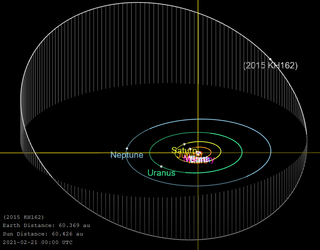
2015 KH162 is a large trans-Neptunian object orbiting in the scattered disc region of the outermost Solar System. First observed in 2015, this minor planet is one of the most distant objects from the Sun at 60.6 AU, or twice as far as Neptune.

2013 SY99, also known by its OSSOS survey designation uo3L91, is a trans-Neptunian object discovered on September 29, 2013 by the Outer Solar System Origins Survey using the Canada–France–Hawaii Telescope at Mauna Kea Observatory. This object orbits the Sun between 50 and 1,300 AU (7.5 and 190 billion km), and has a barycentric orbital period of nearly 20,000 years.It has the fourth largest semi-major axis for an orbit with perihelion beyond 38 AU. 2013 SY99 has one of highest perihelia of any known extreme trans-Neptunian object, behind sednoids including Sedna (76 AU), 2012 VP113 (80 AU), and Leleākūhonua (65 AU).
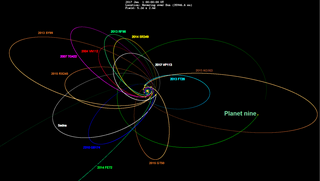
2015 KG163, also known as o5m52, is a trans-Neptunian object from the outermost region of the Solar System, approximately 102 kilometers (63 miles) in diameter. It was first observed on 24 May 2015, by astronomers of the Outer Solar System Origins Survey using the Canada–France–Hawaii Telescope at Mauna Kea Observatories, Hawaii, United States. With an observation arc of 2 years, it passed perihelion around August 2022 at a velocity of 6.5 km/s with respect to the Sun.

541132 Leleākūhonua, provisionally designated 2015 TG387, is an extreme trans-Neptunian object and sednoid in the outermost part of the Solar System. It was first observed on 13 October 2015, by astronomers at the Mauna Kea Observatories, Hawaii. Based on its discovery date near Halloween and the letters in its provisional designation 2015 TG387, the object was informally nicknamed "The Goblin" by its discoverers and later named Leleākūhonua, comparing its orbit to the flight of the Pacific golden plover. It was the third sednoid discovered, after Sedna and 2012 VP113, and measures around 220 kilometers (140 miles) in diameter.
2015 FJ345 is a trans-Neptunian object and detached object, located in the scattered disc, the outermost region of the Solar System. It was first observed on 17 March 2015, by a team led by American astronomer Scott Sheppard at the Mauna Kea Observatories, in Hawaii, United States. With its perihelion of almost 51 AU, it belongs to a small and poorly understood group of very distant objects with moderate eccentricities. The object is not a dwarf planet candidate as it only measures approximately 120 kilometers (75 miles) in diameter.

2018 VG18 is a distant trans-Neptunian object that was discovered well beyond 100 AU (15 billion km) from the Sun. It was first observed on 10 November 2018 by astronomers Scott Sheppard, David Tholen, and Chad Trujillo during a search for distant trans-Neptunian objects whose orbits might be gravitationally influenced by the hypothetical Planet Nine. They announced their discovery on 17 December 2018 and nicknamed the object "Farout" to emphasize its distance from the Sun.
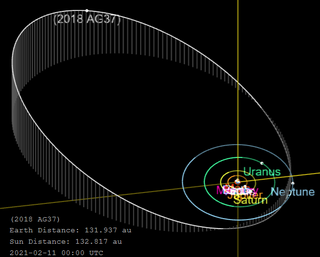
2018 AG37 is a distant trans-Neptunian object and centaur that was discovered 132.2 ± 1.5 AU (19.78 ± 0.22 billion km) from the Sun, farther than any other currently observable known object in the Solar System. Imaged in January 2018 during a search for the hypothetical Planet Nine, the confirmation of this object was announced in a press release in February 2021 by astronomers Scott Sheppard, David Tholen, and Chad Trujillo. The object was nicknamed "FarFarOut" to emphasize its distance from the Sun.

2014 SV349 is a large trans-Neptunian object from the scattered disc located in the outermost region of the Solar System. It is one of the most distant objects from the Sun at 60.5 AU. The object is a dwarf planet candidate and measures approximately 423 kilometers (260 miles) in diameter. It was discovered on 19 September 2014, by American astronomer Scott Sheppard at the Cerro Tololo Observatory, Chile, and was provisionally designated 2014 SV349.
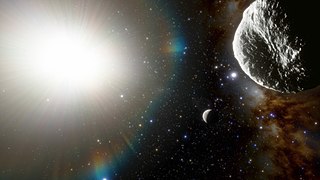
2021 PH27 is a near-Earth asteroid of the Atira group. It was discovered by Scott Sheppard using the Dark Energy Survey's DECam imager at NOIRLab's Cerro Tololo Inter-American Observatory on 13 August 2021. 2021 PH27 has the smallest semi-major axis and shortest orbital period among all known asteroids as of 2021, with a velocity at perihelion of 106 km/s (240,000 mph). It also has the largest value of the relativistic perihelion shift, 1.6 times that of Mercury. With an absolute magnitude of 17.7, the asteroid is estimated to be larger than 1 kilometer (0.6 miles) in diameter.
2015 FG415 is a trans-Neptunian object from the scattered disc, located in the outermost region of the Solar System. It was discovered on 17 March 2015, by American astronomer Scott Sheppard at the Mauna Kea Observatories, Hawaii, and received the provisional designation 2015 FG415. As of 2021, it is the 9th-most-distant object from the Sun at 87.2 AU and measures approximately 280 kilometers (170 miles) in diameter.
2014 UE228 is a trans-Neptunian object from the outermost region of the Solar System. The object is in a rare 3:8 resonance with Neptune and measures approximately 93 kilometers (58 miles) in diameter. It was first observed on 22 October 2014, by astronomers with the Outer Solar System Origins Survey at the Mauna Kea Observatories, Hawaii, and was provisionally designated 2014 UE228. As of 2021, it has not been numbered.
2021 LL37 is a large trans-Neptunian object in the scattered disc, around 600 kilometres (370 miles) in diameter. It was discovered on 12 June 2021, by American astronomers Scott Sheppard and Chad Trujillo using Cerro Tololo Inter-American Observatory's Dark Energy Camera in Chile, and announced on 31 May 2022. It was 73.9 astronomical units from the Sun when it was discovered, making it one of the most distant known Solar System objects from the Sun as of May 2022. It has been identified in precovery images from as far back as 28 April 2014.
References
- 1 2 3 "MPEC-2022-S118 : 2021 RR205". Minor Planet Electronic Circular. Minor Planet Center. 21 September 2022. Retrieved 21 September 2022.
- 1 2 3 4 "JPL Small-Body Database Browser: (2021 RR205)" (2022-09-03 last obs.). Jet Propulsion Laboratory . Retrieved 21 September 2022.
- 1 2 Sheppard, Scott S. "Scott Sheppard Small Body Discoveries". Earth and Planets Laboratory. Carnegie Institution for Science. Retrieved 10 October 2022.
- 1 2 3 "2021 RR205". Minor Planet Center. International Astronomical Union. Retrieved 21 September 2022.
- 1 2 "JPL Horizons On-Line Ephemeris for 2021 RR205 at epoch JD 2460000.5". JPL Horizons On-Line Ephemeris System . Jet Propulsion Laboratory. Retrieved 21 September 2022. Solution using the Solar System Barycenter. Ephemeris Type: Elements and Center: @0)
- ↑ "Asteroid Size Estimator". Center for Near Earth Object Studies. Jet Propulsion Laboratory. Retrieved 21 September 2022.
- 1 2 Bannister, Michele; Shankman, Cory; Volk, Katherine (2017). "OSSOS: V. Diffusion in the orbit of a high-perihelion distant Solar System object". The Astronomical Journal. 153 (6): 262. arXiv: 1704.01952 . Bibcode:2017AJ....153..262B. doi: 10.3847/1538-3881/aa6db5 . S2CID 3502267.

